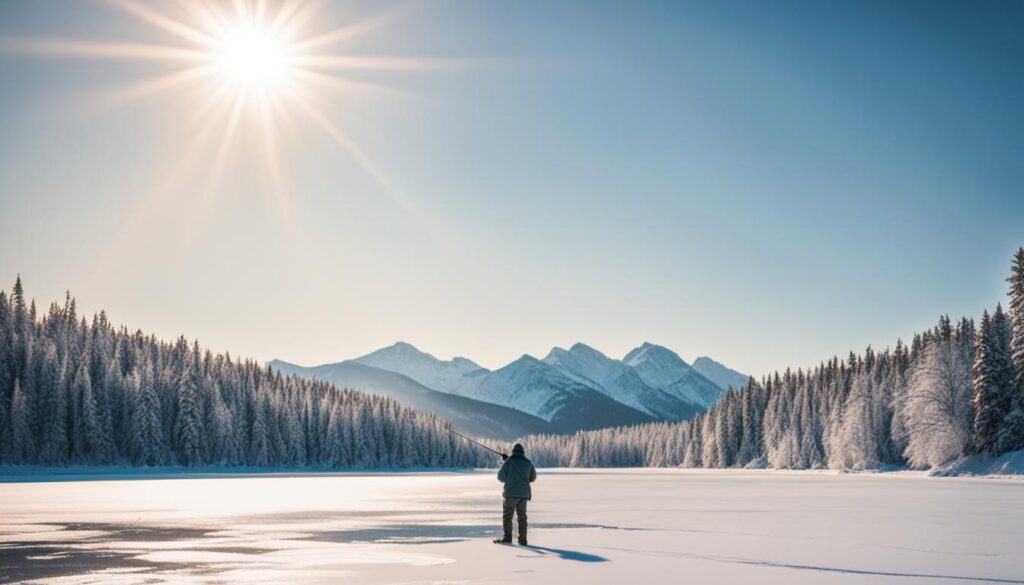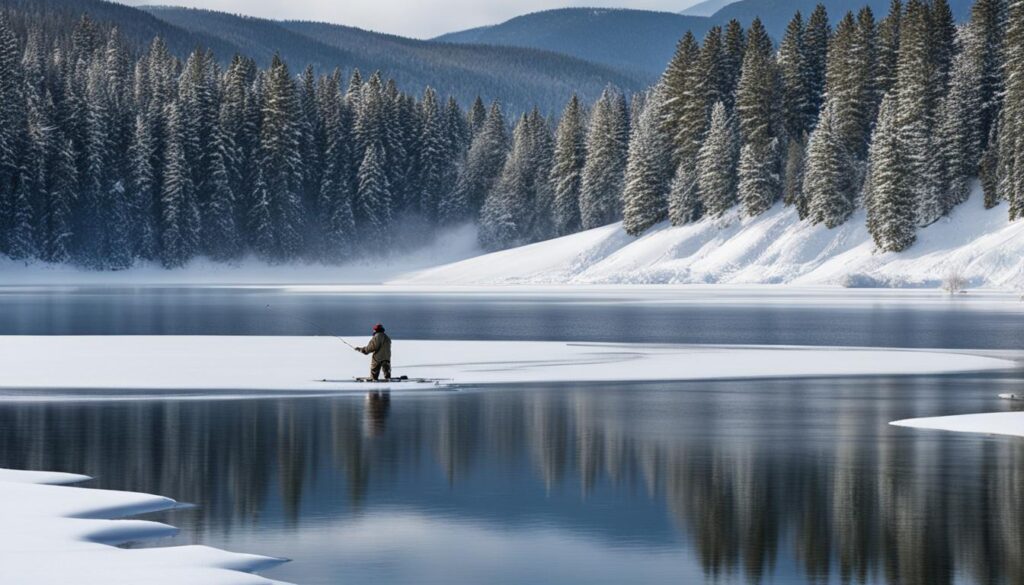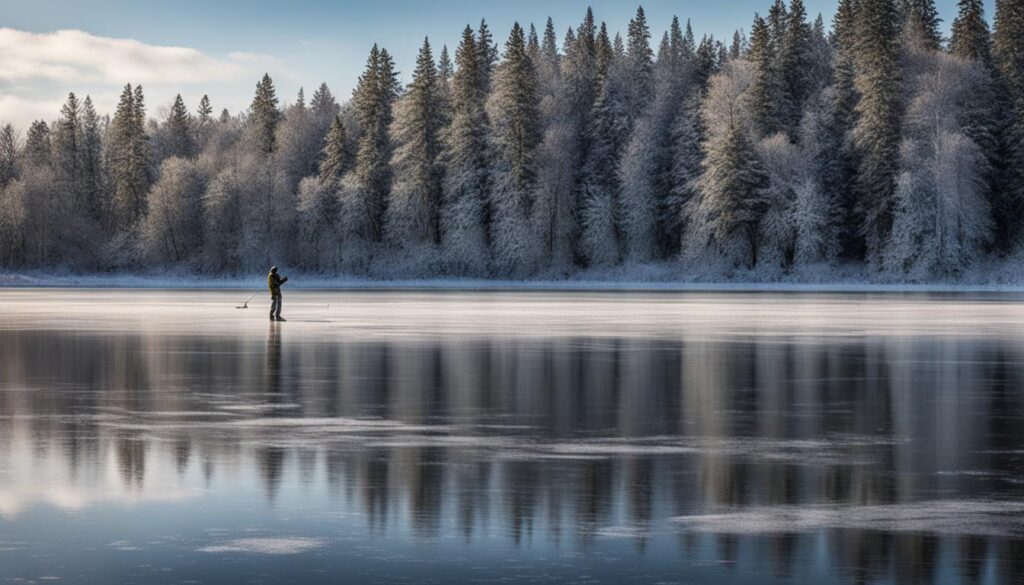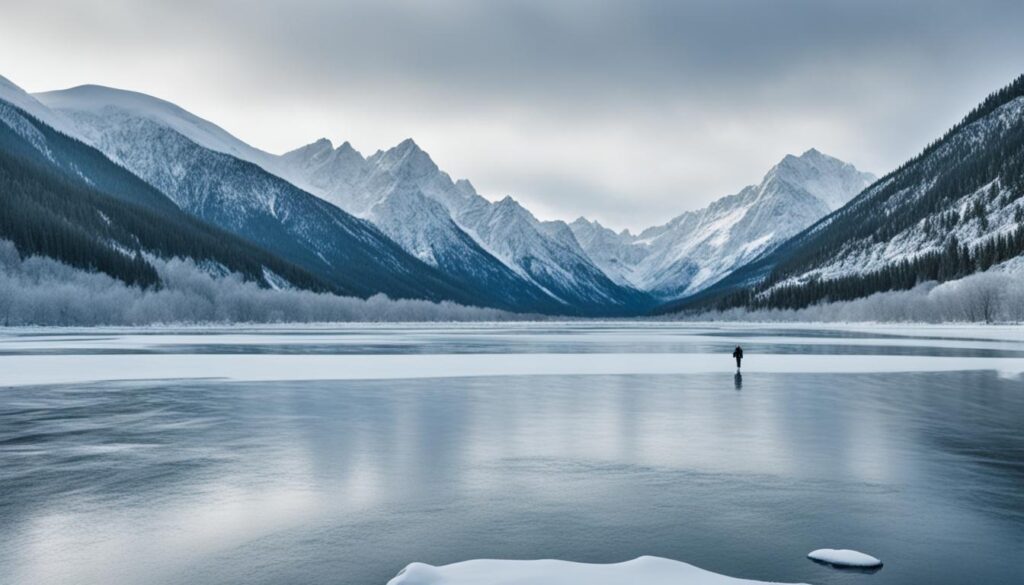Winter bass fishing presents a unique challenge for anglers, with frigid water temperatures and sluggish bass making it difficult to land a catch. However, with the proper techniques and strategies, you can increase your success rate and reel more winter bass bites. This article’ll explore proven tips and cold-water bass fishing techniques that will help you fish confidently in frigid water.
Angler’s Essentials:
- Fish confidently in the frigid water for more winter bass bites
- Utilize winter bass fishing tips and techniques to improve your catch rate
- Choose the right baits based on water temperature and bass behavior
- Target high-percentage areas and structures for optimal fishing
- Use appropriate gear and clothing to stay comfortable and safe
Choosing the Right Baits for Winter Bass Fishing
When it comes to winter bass fishing, selecting the right bait is essential for success. The cold water conditions and bass behavior in winter require specific strategies and techniques. Choosing the best baits can significantly increase your chances of catching bass in frigid water.
Effective Bait Options for Winter Bass Fishing
Here are some effective bait options that have proven to be successful in winter bass fishing:
- Small crankbaits: Crankbaits with a smaller profile work well in cold water. Opt for shallow diving crankbaits that imitate the prey bass feed on during winter.
- Finesse jigs: Finesse jigs are excellent choices for cold-water bass fishing. They offer a lifelike presentation and can be fished slowly to entice lethargic bass.
- Swimbaits: Swimbaits are versatile baits that can be retrieved slowly or fast to trigger reaction strikes. Choose swimbaits of appropriate size and color, considering the water temperature and clarity.
“When fishing in frigid water, it’s crucial to use baits that mimic the natural forage and match the bass’s feeding patterns during winter. A thorough understanding of the underwater ecosystem and adapting your bait selection accordingly can make a significant difference in your fishing success.”
By utilizing these frigid water fishing strategies and techniques, you can enhance your winter fishing for bass and increase your chances of hooking into some trophy-sized fish. In the next section, we will discuss the ideal times and locations to fish for bass during winter.
When and Where to Fish in Winter
Knowing when and where to fish in winter is essential for success. Bass tend to move to deeper water and focus on structure during this time. The best locations to target include rocky areas, wood cover, and vegetation, if present. Pay attention to water temperature and look for high-percentage areas with the most potential for bites.
To increase your winter bass bites, it’s important to consider the following skills and techniques:
- Understand Bass Behavior: In cold conditions, bass become less active and seek out warmer water and areas with cover. Look for deep water structures such as points, ledges, and drop-offs where bass may gather.
- Monitor Water Temperature: Use a thermometer to check the water temperature regularly. Bass are more likely to bite when the temperature is slightly warmer, even if it’s just a few degrees difference.
- Focus on High-Percentage Areas: Pay attention to areas with cover and structure that provide potential hiding spots for bass. Target rocky areas, submerged trees, brush piles, and weed beds where bass will likely seek shelter.
- Adjust Tactics Based on Conditions: Experiment with different baits, presentations, and retrieval speeds to find what works best in your local waters. Be willing to adapt and try new techniques as the conditions change.

Gear Considerations for Winter Bass Fishing
When it comes to winter bass fishing, having the right gear can make all the difference. You can fish confidently in the frigid water for more winter bass bites by choosing the appropriate equipment. Here are some winter bass fishing tips to consider when selecting your gear:
1. Opt for Spinning Gear with Lighter Line
Spinning gear is ideal for winter bass fishing, allowing for longer and more accurate casts. Pair your spinning reel with a lighter line, such as a 6-10 lb test, to improve your casting distance and increase your chances of reaching those deeper, hard-to-reach spots where bass may be hiding. A lighter line also provides better line management, allowing you to play the fish better and increase your hook-up rate.
2. Consider Using Monofilament Line
In colder water temperatures, a monofilament line can be a great choice. It offers a little stretch, which can help prevent sudden line breaks when the bass strikes. Additionally, the monofilament line tends to have fewer line twists than other types of line, making it easier to manage in frigid conditions. Remember to match the line weight to your chosen fishing technique and the size of your target bass.
3. Dress Appropriately and Ensure Safety
Staying warm and comfortable during winter bass fishing is essential for a successful and enjoyable experience. Layer your clothing to trap heat and protect yourself from the chilly winds. Wear thermal socks, insulated boots, gloves, and a warm hat to keep your extremities cozy. Remember to wear a life jacket or a personal flotation device for safety, as the risk of falling into cold water during winter fishing could lead to hypothermia.
Winter Bass Fishing Techniques
When bass becomes inactive in cold water, finesse techniques like drop shotting, Neko rigging, and Ned rigging can entice bites with subtle, natural movements. Power fishing with swimbaits, crankbaits, and Alabama rigs triggers reaction strikes by mimicking fleeing prey for a more aggressive approach. Choosing the proper techniques for the conditions and targeting bass near cover and transition areas are keys to success.
Tips for Fishing in Extreme Cold Weather
Fishing in extreme cold weather requires some additional preparation. The frigid temperatures can make it challenging to stay comfortable and maintain dexterity, but with these tips, you can enhance your winter bass fishing skills and improve your chances of success.
Dress Appropriately
Dressing appropriately is one of the most important aspects of fishing in extreme cold weather. Layering your clothing is critical to staying warm and regulating your body temperature. Start with a moisture-wicking base layer to keep sweat away from your skin, add an insulating mid-layer for warmth, and finish with a waterproof and windproof outer layer to protect against the elements. Remember to wear a hat, gloves, and insulated boots to warm your extremities.
Protect Your Gear
Cold weather can wreak havoc on your fishing gear, so taking steps to protect it is essential. Use line conditioner or cooking spray on your rod guides to prevent freezing and reduce ice buildup. This will help maintain smooth line movement and prevent frustrating tangles. Store your tackle and equipment in a dry, insulated bag to avoid damage from moisture and extreme temperatures.
Stay Comfortable
Fishing in extreme cold weather can be uncomfortable, but there are ways to mitigate the harsh conditions. Consider wearing cheap polyester/cotton work gloves underneath your fishing gloves to provide extra warmth and protection for your hands. These gloves can also help you avoid direct contact with the cold rod grip, which can be uncomfortable and decrease dexterity. You can use hand warmers or Sterno heat packets to keep your hands warm throughout the day. These small packets can be tucked into your gloves or pockets for warmth.
Remain Safe
Safety should always be a top priority when fishing in extreme cold weather. Before heading out, check the weather forecast and ice conditions to ensure it’s safe to fish. If you’re ice fishing, make sure the ice thickness is suitable for walking on, and always carry safety equipment like ice picks, a rescue rope, and a flotation device. It’s also crucial to let someone know your fishing plans and when you expect to return home.
Fishing in extreme cold weather requires additional preparation and precautions but can also be gratifying. With the proper cold water bass fishing techniques and winter bass fishing skills, you can increase your chances of success and enjoy the thrill of catching bass in frigid conditions.

| Tips for Fishing in Extreme Cold Weather |
|---|
| Dress Appropriately |
| Protect Your Gear |
| Stay Comfortable |
| Remain Safe |
The Importance of Confidence in Winter Bass Fishing
Confidence is a crucial ingredient for success in winter bass fishing. It goes hand in hand with having the right skills, knowledge, and techniques to catch bass in colder temperatures. When you have confidence in your chosen baits and techniques, you’ll be more motivated and focused on the water, increasing your chances of landing that prize-winning bass.
Trusting your instincts is crucial in winter bass fishing. As you spend time on the water and gain experience, you’ll understand what works best in different conditions. Feel free to make adjustments based on the water temperature, clarity, and bass behavior. Adaptability is essential for maximizing your success rate.
“Confidence comes not from always being right, but from not fearing to be wrong.” – Peter T. Mcintyre
When you fish confidently, you exude a certain aura that can attract bass. Bass are highly perceptive and can sense hesitation or lack of confidence in your approach. Being confident and assertive can trigger a reaction strike from even the most stubborn winter bass.
Don’t underestimate the power of positive thinking. Visualize yourself succeeding and landing that trophy bass. Positive thoughts can help build confidence and keep you focused on the task. Remember, confidence breeds success.
So, go with a positive mindset and unwavering confidence the next time you head out for a winter bass fishing expedition. Trust in your skills, adapt to the conditions, and remain persistent. With confidence as your ally, you’ll be well on your way to a successful winter bass fishing season.
Winter Bass Fishing Confidence Tips:
- Prepare your gear and equipment in advance to build confidence.
- Stay up to date with the latest winter bass fishing techniques and strategies.
- Focus on the positives and learn from any setbacks.
- Trust your instincts and make adjustments based on the conditions.
- Stay persistent and don’t give up, even if the bites are slow.
Recommended Baits for Winter Bass Fishing
When it comes to winter bass fishing, using the right baits can significantly affect your success rate. Certain baits have proven to be highly effective in enticing winter bass bites. Whether you prefer finesse or power fishing baits, experimenting with different colors and sizes can help you find what works best in your local waters.
Finesse Baits
- Dropshot Worms: These small, slender worms rigged on a dropshot rig can be incredibly effective in enticing bites from lethargic bass. The worm’s subtle presentation and natural movement can tempt even the fussiest winter bass. Feel free to downsize your baits for better results.
- Ned Rigs: Ned rigs, consisting of a mushroom-shaped jighead and a finesse worm, are versatile and can trigger bites even in cold water. The slow, gliding action of the lure can mimic an easy meal, making it an irresistible choice for winter bass.
- Small Swimbaits: Swimbaits come in various sizes and designs, but for winter bass fishing, opt for smaller models. These baits can imitate injured baitfish and create a realistic presentation. You can use a slow and steady retrieve to entice bites from the bass.
Power Fishing Baits
- Jigs: Jigs are versatile baits effective year-round, including during winter. Choose smaller-sized jigs with subtle color patterns and pair them with a finesse trailer. Target rocky structures and slow-roll the jig along the bottom to trigger reaction strikes.
- Crankbaits: Cold-water crankbaits designed for slow retrieves can be excellent for attracting winter bass. Opt for smaller, shad-imitating crankbaits in natural colors. Experiment with different depths and retrieve speeds to find what triggers bites in your fishing spot.
- Spinnerbaits: Spinnerbaits with smaller blades and lighter wire are ideal for winter bass fishing. Slow-roll the spinnerbait near cover and structure to provoke reaction strikes. Vary your retrieve speed and experiment with different blade colors to find what works best.
Remember, winter bass can be more selective in their feeding patterns, so presenting your bait naturally and enticingly is essential. Pay attention to the behavior and preferences of the bass in your local waters. Don’t hesitate to switch between finesse and power fishing baits to maximize your chances of increasing winter bass bites.

Conclusion
Winter bass fishing can be a challenging but rewarding pursuit. You can increase your catch rate by employing the right strategies, using effective baits and techniques, and fishing confidently even in frigid conditions. If available, pay attention to water temperature and focus on high-percentage areas with structures such as rocks, wood cover, and vegetation.
Having the right gear is essential for success in winter bass fishing. Use a spinning gear with a lighter line to cast farther and play the fish better. Consider using a monofilament line for its stretch and resistance to line twists in colder water. Appropriate clothing and safety equipment will also ensure you stay protected and comfortable on the water.
You can just experiment with different baits to find what works best in your local waters. Finesse techniques like dropshotting, Neko rigging, and Ned rigging can effectively entice lethargic bass. In contrast, power fishing techniques such as swimbaits, crankbaits, and Alabama rigs can trigger reaction strikes. Remember to adjust based on the conditions, trust your instincts to fish confidently, and improve your success rate.
Stay safe on the water by preparing for extreme cold weather conditions. Use line conditioner on your rod guides to prevent freezing, and wear gloves to protect your hands from the cold. Hand warmers or Sterno heat can also help keep your hands warm throughout the day. With the right approach and precautions, winter bass fishing can provide exciting catches and memorable experiences.
FAQ
What are some effective baits for winter bass fishing in frigid water?
Some effective baits for winter bass fishing in frigid water include small crankbaits, finesse jigs, and swimbaits. The choice of bait should be based on water temperature, clarity, and the behavior of the bass in cold conditions.
When and where should I fish for bass in winter?
Bass tend to move to deeper water and focus on structure during winter. Target rocky areas, wood cover, and vegetation if present. Pay attention to water temperature and look for high-percentage areas that offer the most potential for bites.
What gear should I use for winter bass fishing?
Opt for spinning gear with lighter line to cast farther and play the fish better. Consider using monofilament line for less line twisting in colder water. It’s also important to have appropriate clothing and safety equipment for protection and comfort on the water.
What techniques should I use for winter bass fishing?
Finesse fishing techniques like dropshotting, Neko rigging, and Ned rigging can be effective for enticing lethargic bass in winter. Power fishing techniques like using swimbaits, crankbaits, and Alabama rigs can also trigger reaction strikes. Slow and subtle movements are key to getting bites.
How can I prepare for fishing in extreme cold weather?
Use line conditioner or cooking spray on your rod guides to prevent freezing. Wear cheap polyester/cotton work gloves to protect your hands and avoid direct contact with the rod grip. Hand warmers or Sterno heat can help keep your hands warm throughout the day.
How does confidence play a role in winter bass fishing?
Confidence is crucial in winter bass fishing. Having confidence in your chosen baits and techniques increases motivation and focus on the water. Trust your instincts and make adjustments based on the conditions to improve your success rate.
What are some recommended baits for winter bass fishing?
Recommended baits for winter bass fishing include finesse baits like dropshot worms, Ned rigs, and small swimbaits. Power fishing baits like jigs, crankbaits, and spinnerbaits can also be effective for triggering reaction strikes.
